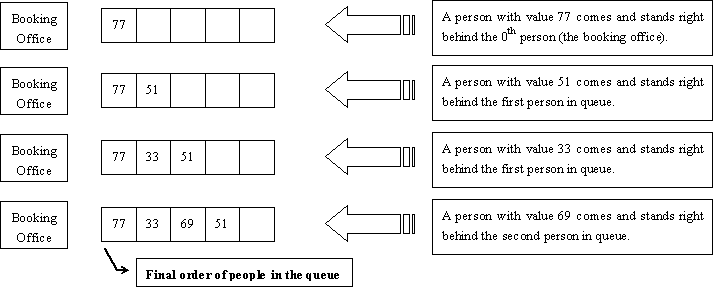poj-2828 Buy Tickets(线段树,排队问题,逆向思维)
题目地址:POJ 2828 Buy Tickets
Description
Railway tickets were difficult to buy around the Lunar New Year in China, so we must get up early and join a long queue…
The Lunar New Year was approaching, but unluckily the Little Cat still had schedules going here and there. Now, he had to travel by train to Mianyang, Sichuan Province for the winter camp selection of the national team of Olympiad in Informatics.
It was one o’clock a.m. and dark outside. Chill wind from the northwest did not scare off the people in the queue. The cold night gave the Little Cat a shiver. Why not find a problem to think about? That was none the less better than freezing to death!
People kept jumping the queue. Since it was too dark around, such moves would not be discovered even by the people adjacent to the queue-jumpers. “If every person in the queue is assigned an integral value and all the information about those who have jumped the queue and where they stand after queue-jumping is given, can I find out the final order of people in the queue?” Thought the Little Cat.
Input
There will be several test cases in the input. Each test case consists of N + 1 lines where N (1 ≤ N ≤ 200,000) is given in the first line of the test case. The next N lines contain the pairs of values Posi and Vali in the increasing order of i(1 ≤ i ≤ N). For each i, the ranges and meanings of Posi and Vali are as follows:
- Posi ∈ [0, i − 1] — The i-th person came to the queue and stood right behind the Posi-th person in the queue. The booking office was considered the 0th person and the person at the front of the queue was considered the first person in the queue.
- Vali ∈ [0, 32767] — The i-th person was assigned the value Vali.
There no blank lines between test cases. Proceed to the end of input.
Output
For each test cases, output a single line of space-separated integers which are the values of people in the order they stand in the queue.
Sample Input
Sample Output
Hint
The figure below shows how the Little Cat found out the final order of people in the queue described in the first test case of the sample input.

题意:
排队买票时候插队。
给出一些数对,分别代表某个人的想要插入的位置pos_i和他的val_i,求出最后的队列的val顺序。
分析:
这是一道很巧妙的题目。
观察发现,最后一个插入到该位置的人位置是固定的,那么我们可以从后面进行插入操作,pos ,val 代表val要插入到pos位置,那么就是说 pos 前面要留出 pos个位置,
我们可以反着来考虑,从后面开始站,后面的人位置一旦确定就不会再改变了,假设后面的人都已经站在正确的位置上了,那么到那个人站的时候,现在的位置上已经都是后面的那些人了,只要数num个空格,那那个人站的位置能确定了。
举个例子,例子来于crazy_apple,谢~
线段树节点中保存这一段中的空位数,然后倒序对pos插入:
例如: 0 77
1 51
1 33
2 69
先取: 2 69 —— —— —69— —— (需要前面有3个空位才能插入)
然后取: 1 33 —— —33— —69— —— (需要前面有2个空位才能插入)
然后取: 1 51 —— —33— —69— —51— (需要前面有2个空位才能插入) 前面只有1个空位 故插入后面空格
然后取: 0 77 —77— —33— —69— —51— (需要前面有1个空位才能插入)
旧代码:
#include <stdio.h>
#include <string.h>
#include <iostream>
#include <string>
#include <math.h>
#include <algorithm>
#include <queue>
#include <set>
#include <math.h>
const int INF=0x3f3f3f3f;
typedef long long LL;
const int maxn=2e5+;
using namespace std; int n;
int Add[maxn<<];//空位数
int pos[maxn];//要插入的位置
int val[maxn];//初始的值
int ans[maxn];//最终站位 void Build(int l,int r,int rt)
{
Add[rt]=r-l+;//初始空位数
if(l==r)
return ;
int m=(l+r)>>;
Build(l,m,rt<<);
Build(m+,r,rt<<|);
} int Update(int l,int r,int num,int rt)//num为插队需要前面有多少个空位
{
Add[rt]--;//空位数减1
if(l==r)
return l;//返回插入位置
int m=(l+r)>>;
if(Add[rt<<]>=num)//当左孩子的空格大于等于插入位置时往左边插入
Update(l,m,num,rt<<);
else//当左边的空格小于num,则插入右边,插入右边位置num应该减左边的空格数
{
num-=Add[rt<<];
Update(m+,r,num,rt<<|);
}
} int main()
{
while(~scanf("%d",&n))
{
Build(,n,);
for(int i=;i<=n;i++)
{
scanf("%d %d",&pos[i],&val[i]);
}
for(int i=n;i>=;i--)//倒过来更新,则可以确定最后的位置
{
int key=Update(,n,pos[i]+,);//得到插入地方
ans[key]=val[i];//存入ans数组
}
for(int i=;i<=n;i++)
{
if(i!=)
printf(" ");
printf("%d",ans[i]);
}
printf("\n");
}
return ;
}
习惯改变了,更新下写法:
#include <stdio.h>
#include <string.h>
#include <iostream>
#include <string>
#include <math.h>
#include <algorithm>
#include <vector>
#include <stack>
#include <queue>
#include <set>
#include <map>
#include <sstream>
const int INF=0x3f3f3f3f;
typedef long long LL;
const double eps =1e-;
const int mod=1e9+;
const int maxn=2e5+;
using namespace std; vector<pair<int,int> > vt;
int ans[maxn];//最终站位 struct node
{
int l,r;
int val;//空位数
}Tr[maxn<<]; //void PU(int u) //pushup
//{
// Tr[u].val=Tr[u<<1].val+Tr[u<<1|1].val;
//} void Build(int l,int r,int u)
{
Tr[u].l=l; Tr[u].r=r; Tr[u].val=r-l+; //初始空位数
if(l==r) return ;
int mid=(l+r)>>;
Build(l,mid,u<<);
Build(mid+,r,u<<|);
} void Update(int u,int num,int x) //num为插队需要前面有多少个空位
{
int l=Tr[u].l; int r=Tr[u].r;
Tr[u].val--;//空位数直接-1,可省去pushup
if(l==r)
{
//Tr[u].val=0;
ans[l]=x;
return ;
}
int mid=(l+r)>>;
if(Tr[u<<].val>=num) Update(u<<,num,x);//当左边的空位 >= num时,往左边插入
else Update(u<<|,num-Tr[u<<].val,x);//当左边的空位 < num,则插入右边,此时num应该减去左边的空位数
//PU(u);
} int main()
{
#ifdef DEBUG
freopen("sample.txt","r",stdin);
#endif int n;
while(~scanf("%d",&n))
{
vt.clear();
Build(,n,);
for(int i=;i<=n;i++)
{
int a,b;
scanf("%d %d",&a,&b);
vt.push_back(make_pair(a,b));
}
for(int i=n-;i>=;i--)//倒过来插入位置,则可以确定最终站位
Update(,vt[i].first+,vt[i].second);
for(int i=;i<=n;i++)
printf(i==n?"%d\n":"%d ",ans[i]);
} return ;
}
-
poj-2828 Buy Tickets(线段树,排队问题,逆向思维)的更多相关文章
- poj 2828 Buy Tickets (线段树(排队插入后输出序列))
http://poj.org/problem?id=2828 Buy Tickets Time Limit: 4000MS Memory Limit: 65536K Total Submissio ...
- POJ 2828 Buy Tickets (线段树 or 树状数组+二分)
题目链接:http://poj.org/problem?id=2828 题意就是给你n个人,然后每个人按顺序插队,问你最终的顺序是怎么样的. 反过来做就很容易了,从最后一个人开始推,最后一个人位置很容 ...
- POJ 2828 Buy Tickets 线段树 倒序插入 节点空位预留(思路巧妙)
Buy Tickets Time Limit: 4000MS Memory Limit: 65536K Total Submissions: 19725 Accepted: 9756 Desc ...
- POJ 2828 Buy Tickets | 线段树的喵用
题意: 给你n次插队操作,每次两个数,pos,w,意为在pos后插入一个权值为w的数; 最后输出1~n的权值 题解: 首先可以发现,最后一次插入的位置是准确的位置 所以这个就变成了若干个子问题, 所以 ...
- POJ 2828 Buy Tickets(线段树·插队)
题意 n个人排队 每一个人都有个属性值 依次输入n个pos[i] val[i] 表示第i个人直接插到当前第pos[i]个人后面 他的属性值为val[i] 要求最后依次输出队中各个人的属性 ...
- POJ 2828 Buy Tickets(线段树单点)
https://vjudge.net/problem/POJ-2828 题目意思:有n个数,进行n次操作,每次操作有两个数pos, ans.pos的意思是把ans放到第pos 位置的后面,pos后面的 ...
- poj 2828 Buy Tickets (线段树)
题目:http://poj.org/problem?id=2828 题意:有n个人插队,给定插队的先后顺序和插在哪个位置还有每个人的val,求插队结束后队伍各位置的val. 线段树里比较简单的题目了, ...
- POJ - 2828 Buy Tickets (段树单点更新)
Description Railway tickets were difficult to buy around the Lunar New Year in China, so we must get ...
- POJ 2828 Buy Tickets(排队问题,线段树应用)
POJ 2828 Buy Tickets(排队问题,线段树应用) ACM 题目地址:POJ 2828 Buy Tickets 题意: 排队买票时候插队. 给出一些数对,分别代表某个人的想要插入的位 ...
- poj 2828 Buy Tickets 【线段树点更新】
题目:id=2828" target="_blank">poj 2828 Buy Tickets 题意:有n个人排队,每一个人有一个价值和要插的位置,然后当要插的位 ...
随机推荐
- java笔记01
java对象数组 Student[] Students = new Student[3]; 与普通数组无差 java集合类 集合类: 面向对象对事物的描述是通过对象来体现的. 为了方便对多个对象进行操 ...
- 寒假day19
今天编写了人才动态模块,同时刷了一些算法题.
- 分页助手PageHelper学习
PageHelper是mybatis的通用分页插件,通过mybatis的拦截器实现分页功能,拦截sql查询请求,添加分页语句, 最终实现分页查询功能.在 springboot上集成pagehelper ...
- ArrayList源码阅读笔记
ArrayList ArrayList继承自AbstractList抽象类,实现了RandomAccess, Cloneable, java.io.Serializable接口,其中RandomAcc ...
- redis常用命令--基础
redis默认有个数据库,下标从开始,不支持自定义数据库名字. 使用select index 切换数据库 : select 7 (切换到第八个数据库) dbsize:求当前数据库中键值对的数量. ...
- Arduino IIC 主从设备连接通信
目的: 实现Arduino主从设备之间的互相IIC通信,掌握IIC通信协议的使用方法. 器材: Arduino UNO R3 一块 Arduino Nano 三块 面包板 导线 3K ...
- HyperLedger Cello学习笔记
HyperLedger Cello学习笔记 转载请注明出处:HyperLedger Cello学习笔记 概述 Hyperledger Cello是Hyperledger下的一个子项目,其主要功能如下: ...
- Causal Corpus 事件因果关系语料统计
Causal Corpus 事件因果关系语料统计 本文是对因果关系抽取领域数据库标注及开源情况的统计.除了对因果关系的标注,一些类似的语料也包含在内,从而为语料的使用提供灵活性,可以根据不同的目标选取 ...
- 68.ORM查询条件:date,time,year,week_day等
1. date: 首先查看数据库中article表的信息,由表中的create_time字段可以看出时间为2020.2.5 打印出查询的结果: <QuerySet []>:但是查询的结果为 ...
- List、Set和Map详解及其区别和他们分别适用的场景
Java中的集合包括三大类 它们是Set(集).List(列表)和Map(映射),它们都处于java.util包中,Set.List和Map都是接口,它们有各自的实现类.Set的实现类主要有HashS ...
